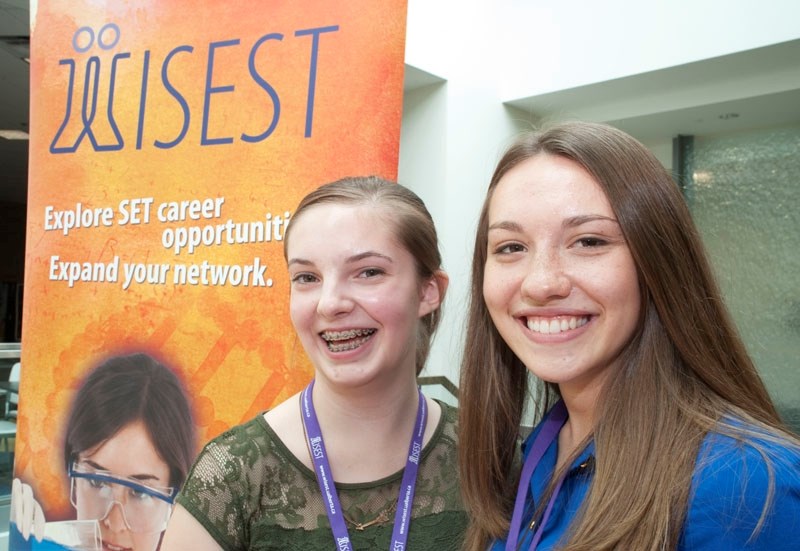Natalia Rudolf spent her summer breaking hips.
Fellow student Grace Silver spent it dosing fungi with powerful acids, deadly ozone and frigid dry ice, all in a high-tech lab full of dials, gas cylinders and fume hoods.
"I loved it. It was so cool," says Silver, a Grade 11 student at Paul Kane.
"It kind of (looked) like a James Bond submarine room."
Silver and Rudolf spent the last six weeks nose-deep in science at the University of Alberta as part of the Women in Scholarship, Engineering, Science and Technology (WISEST) summer research program. The annual event, now in its 30th year, gives male and female Grade 11 students a chance to get hands-on, paid experience with scientific research.
It's important to have gender balance in the workplace because men and women have different skills, says Denise Hemmings, chair of WISEST. But family pressures and years of discrimination have skewed some scientific fields heavily towards men: less than 15 per cent of computer science students at the U of A are women, for example.
WISEST tries to fix this imbalance by giving male and female students a chance to do six weeks of real, paid research in fields atypical for their gender: engineering and math for girls and nursing and nutrition for boys, for example.
Rudolf and Silver were two of the 40 students (37 girls, three boys) accepted into this year's summer research program. About 160 applied, Hemmings says.
The students wrapped up their summer research this Thursday with public presentations on everything from arctic hurricanes to fibre in beans.
Hips and fungi
Rudolf, a Grade 11 student at St. Albert Catholic High, says she heard about WISEST through school and a cousin who went through it. She has a long-time interest in science, particularly the biomedical field.
"I have a body and I know what the pelvis looks like and I can feel it on myself," she says. That makes biology and chemistry more hands-on than other, more esoteric sciences like physics, she says.
Rudolf says she worked to create 3D models of the pelvis using scores of 2D CT scans of hips from 14 real people. She then worked with another WISEST student to simulate hip fractures using the models.
Rudolf says this research should help doctors develop new treatments for hip fractures, which are usually tough to treat.
"The fact that we can help the world and help the scientific community — it's just rewarding."
Silver says she's a big fan of biology and chemistry and hopes to get into the pharmaceutical field.
"Everything that's living is biology, and everything that's living and nonliving is chemistry," she says.
"We can understand the world better with these subjects."
Silver was part of a larger study to figure out how to produce the cholesterol-busting substance lovastatin. Synthetic versions of it are worth billions, and researchers want to find out how to make it more easily, she explains.
Silver says researchers know that dihydromonacolin (DHML) is a precursor to lovastatin, but don't know what makes DHML. Her goal was to test two possible sources of DHML produced by a lab-engineered fungus — a Herculean effort that took over a week's work.
First, she had to grow a bunch of white, fuzzy, ball-like fungi in a flask kept at a constant 30 C while spinning at 225 rpm for five days. She then had to squeeze the excess liquid out of the fungi ("It kind of looks like cookie dough," she says) and dump it into another flask of liquid to get the fungi to produce the stuff she wanted.
After dosing the liquid with water, brine, baking soda and hydrochloric acid, filtering it through six inches of silica gel for an hour and sucking off the excess liquid, she ended up with about 300 milligrams of white, solid material containing the possible DHML sources. She then mixed the material with hydrochloric acid, ozone and other substances to try and make DHML.
It's always a little nerve-wracking to work with these dangerous materials, Silver says. "You've got your goggles and lab coat and gloves on, you're in the fume hood – you know it's serious stuff."
Silver is now waiting for results from the University of California, Los Angeles, to see if she actually managed to make DHML.
Silver says it was a lot of fun working with grad students and doing this research.
"I learned so much about myself and about the world."
Rudolf says WISEST opened a lot of doors for her and showed her career options she hadn't thought of before.
"I find it extremely rewarding."
Visit www.wisest.ualberta.ca for details.
Get WISEST
The U of A's WISEST program offers many ways for young men and women to learn about science, including lectures and conferences. Visit www.wisest.ualberta.ca for details.




